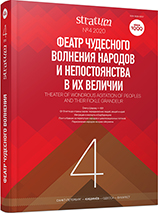Гуннские древности Северо-Восточного Прикаспия
Hunnic Antiquities from the North-Eastern Caspian Region
Author(s): Andrey E. Astafiev, Evgeny S. BogdanovSubject(s): History, Archaeology, Ancient World, 6th to 12th Centuries, Migration Studies
Published by: Издательский дом Stratum, Университет «Высшая антропологическая школа»
Keywords: Aral-Caspian region; Mangistau; Hunnic antiquities; late Sarmatian culture; funerary rite; chrono-indicator; polychrome style
Summary/Abstract: In 2019, three female burials of the Hunnic epoch were investigated on the northeastern coast of the Caspian Sea, on the Mangyshlak Peninsula. Groups of mounds are located in the immediate vicinity of the urban-type settlement of the era of Barbarian Invasion — Karakabak. Features of the funerary rite are characteristic of the Late Sarmatian circle of sites, most of which are preserved up to the Hunnic time. All burials are under an individual embankment, two in the bottom, one in a narrow rectangular pit. Buried women with annular deformity of the skull were laid in an elongated position on the back and oriented their heads to the north (2 cases) and east (1 case). All these data suggest that nomads closely associated with the populations of the Cis-Urals, the Volga region and the Northern Black Sea region lived near Karakabak. In Karakabak, burials of the nomadic elite, along with objects of Sarmatian appearance (mirrors, spindle), the following dating markers were found: belt and shoe buckles, leaf-shaped pendants, polychrome style items. All these finds are correlated with the “Shipovo horizon”, dated within the second half of the 5th — the first half of the 6th century. Leaf-shaped pendants (neck décor), a silver pendant with a stone insert and rings with cloisonné work inlay are attributes of the “Pontic fashion” and could have been produced on the territory of the city handicraft and trade center (Karakabak) by Byzantine craftsmen.
Journal: Stratum plus. Археология и культурная антропология
- Issue Year: 2020
- Issue No: 4
- Page Range: 179-192
- Page Count: 14
- Language: Russian
- Content File-PDF

